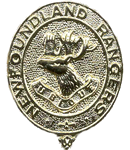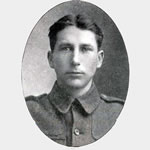Commemorated: | |||
| 1. Memorial: | Beaumont-Hamel (Newfoundland) Memorial | ||
| 2. Book: | The (1921) Masonic Roll of Honour 1914-1918 | Pg.139 | |
| 3. Memorial: | The (1940) Scroll - WW1 Roll of Honour | 20D GQS | |
Awards & Titles: | |||
Family :
Son of John and Adelaide Winter, of Burin North.His portrait image can be found in multiple places including Find-a-Grave. A detailed biography exists at the Newfoundland and Labrador - The Rooms.
Service Life:
Campaigns:
- The First World War 1914-1918, World-wide.
| Unit / Ship / Est.: 1/Newfoundland Regiment |
| Action : The Battles of the Somme 1916 |
The Battle of the Somme 1st July - 18th November 1916 is inevitably characterised by the appalling casualties (60,000) on the first day, July 1st 1916. Having failed to break through the German lines in force, and also failed to maximise opportunities where success was achieved, the battle became a series of attritional assaults on well defended defence in depth. The battle continued officially until 18th November 1916 costing almost 500,000 British casualties. German casualties were about the same, and French about 200,000. The Somme could not be counted a success in terms of ground gained or the cost, but it had a strategic impact as it marked the start of the decline of the German Army. Never again would it be as effective whilst the British Army, learning from its experience eventually grew stronger to become a war winning army. The German High Command recognised that it could never again fight another Somme, a view that advanced the decision to invoke unrestricted submarine warfare in an attempt to starve Britain of food and material, and in doing so accelerated the United States declaration of war thus guaranteeing the eventual outcome. 287 Brethren were killed on the Somme in 1916.
Detail :
WINTER, Randolph Milligan, Corporal, 1/Newfoundland Regiment The Newfoundland Regiment is forever linked with the events of July 1st 1916, the disastrous first day of the Somme, and no Battalion can claim a more emotional story of that day. Newfoundland today is part of Canada but in 1914 it was a colony of Britain. Geographically within Canada but in every other respect British, indeed it remained so until 1948. Therefore when the call to arms came in August 1914 the Newfoundlanders very quickly raised a battalion and it was shipped to Britain where it was integrated within the British Army. It was part of the ?Incomparable? 29th Division, which earned its name at Gallipoli where the Division was numerically speaking, destroyed not once but twice, sustaining over 34,000 casualties. A Division at that time typically had about 18,000 men. The Division was then moved to France following the evacuation of Gallipoli and it found itself at possibly the key location on July 1st, the first day on the Somme, opposite Beaumont Hamel. The Newfoundland account is found in ?The First Five Hundred? which described the plan: ?The Newfoundland Regiment was to start from Newfoundlanders' St. John's Road, a new trench built by the Regiment. They were to cross two support trenches and our firing line, from which they would pass through the gaps in our wire and across to No Man's Land. They were then to cross the first and second German systems, which were supposed to have been taken by the 86th and 87th Brigades, and halt near Puiseux Road while our artillery weakened the third enemy system, which was the objective that our Regiment was to take possession of.? Over an hour after the first wave set out the Newfoundlanders were ordered at 0840hrs to move forward to support the failed attack. The Germans were able to concentrate artillery fire across the whole sector to the two support trenches that the Newfoundlanders were attempting to cross over open ground. The result was dreadful. The Newfoundland Regiment was destroyed. 710 men were casualties. By 1020hrs the sector was quiet apart from the cries of the wounded and the occasional sniper dealing with outstanding matters. Sir Douglas Haig telegraphed: The heroism and devotion to duty they displayed on the 1st July has never been surpassed. Lieutenant-General who commanded the corps said: ?its assault only failed of success because dead men can advance no farther? On a single day when 32 Battalions suffered casualties in excess of 500 the losses of the Newfoundlanders rank amongst the top 3, if not the highest. If we accept that the number of men that were committed from each battalion would be around 800 maximum, the Newfoundlanders had a casualty rate of nearly 90%. Corporal Randolph Milligan WINTER was one of those casualties. We do not know exactly how he died because nobody was left to tell. Those who may have seen him fall, also fell. Randolph was initiated into Freemasonry in April 1913 in Newfoundland and his occupation was described as a Mechanic. He was Passed on 27th November 1913 and Raised on 18th November 1914. At the time of his death he was an officer of his lodge, acting as Lodge Secretary. Also on that day two Masonic Brothers in the Newfoundland Regiment died with Randolph; Captain Eric Stanley AYRE and Frederick Courtney MELLOR both members of WHITEWAY Lodge No 3541 also based in Newfoundland. Newfoundland, because of its ?colonial? status organised its freemasonry under the control of the United Grand Lodge of England rather than a Canadian Grand Lodge. Today the ground over which the Newfoundlanders fell is a permanent memorial. It has been ?preserved? by the Newfoundland government and is one of the most emotive locations on the Western Front. The trench lines can still be seen and the casual visitor looks out from the Caribou memorial (which offers an elevated view from the British front line) and is instinctively drawn towards No Man's Land, the ravine and the cemeteries that mark the valley bottom. They often do not know that the ground on which the men for whom the memorial park is a lasting tribute, actually fell behind the Caribou memorial in a small corner of the park. Most of them never made it that far.
Masonic :
| Type | Lodge Name and No. | Province/District : |
|---|---|---|
| Mother : | Hiram Lodge No. 1281 E.C. | Newfoundland |
Initiated | Passed | Raised |
26th April 1913 | 27th November 1913 | 18th March 1914 |
Secretary
Source :
The project globally acknowledges the following as sources of information for research across the whole database:
- The Commonwealth War Graves Commission
- The (UK) National Archives
- Ancestry.co.uk - Genealogy, Family Trees & Family History online
- ugle.org.uk - The records of the United Grand Lodge of England including the Library and Museum of Freemasonry
Additional Source:
- Founder Researchers : Paul Masters & Mike McCarthy
- Researcher : Bruce Littley

